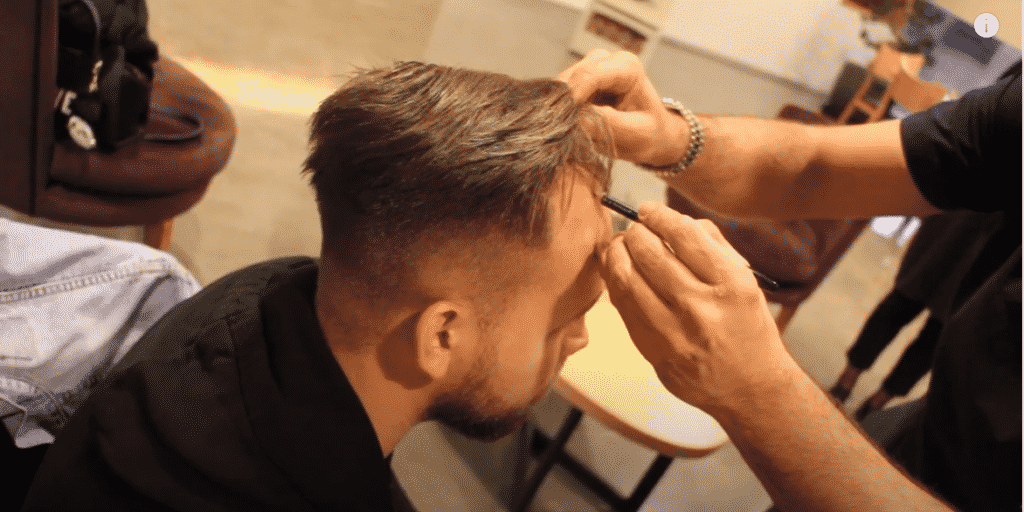A receding hairline is typical in many men as they age. In a majority of cases, hair loss can be treated with either surgery or medication depending on each person’s needs and wants. A receding hairline may be the first step in further hair loss, but it is also possible to retain a full head of hair even with a receding hairline. For women, it is more common to experience diffuse thinning of the hair as opposed to a receding hairline, however, it is still possible.
What Are The Symptoms Of A Receding Hairline?
A receding hairline can occur at any time after puberty and by the time they reach their late 30s, many men have a receding hairline. Typically, this process starts above the temples before moving back across the top of the head, commonly resulting in a ring of hair around the top of a bare scalp. Though thinning hair may continue to grow on top. A receding hairline can also begin above the temples while leaving hair in the middle of the forehead unaffected resulting in a V-shaped pattern commonly called a “widow’s peak”.
In advanced stages, the sides and back of the head can eventually become bald, though most men are typically left with some hair. In women, the sides and back are typically spared, but the part widens over the top of the scalp and things considerably.
What causes a receding hairline?
The average person’s scalp has about 100,000 hair follicles beneath the skin’s surface. From here, the hairs grow before eventually falling out, only to be replaced by new hairs. Typically, people lose anywhere from a few dozen to over a hundred hairs every day. If hair follicles are damaged, or there is some medical reason that disturbs the growth cycle, the result can be a receding hairline.
Genetics
A receding hairline is likely a hereditary trait, with hair follicles being overwhelmed by certain male hormones. Men who have a family history of baldness (especially on their mother’s side) are more likely to lose their hair, though even those with no family history may experience hair loss. The timing of hair loss is often similar from one generation to the next.
Hormonal Changes
Changes in hormones can also cause hair loss in women, though the role of hormones in female pattern hair loss is less clear than in male pattern baldness. Menopause, for example, has been shown to lead to thinning hair.
How Is A Receding Hairline Diagnosed?
The best course of action for anyone concerned with hair loss is to consult a dermatologist. The first test your doctor is likely to perform is a “pull test” in which they gently pull on a few hairs to see how many, or how easily, they fall out. A biopsy of your scalp tissue or hair may also be needed in order to determine if there is an infection causing hair loss.
During a biopsy, your doctor will remove a small amount of tissue from the affected part of the body to be tested in a lab for signs of infection or disease. You may also require a blood test to look for conditions such as thyroid disease which may be contributing to your hair loss.
How Is A Receding Hairline Treated?
The best treatment depends on the specific cause of your hair loss. If it is strictly from genetics, then certain medications may help, but these will only provide temporary benefits. Also, certain styling products and techniques may help to cover the receding hairline without drawing attention as much as shaving your head.
Medications
If you want to slow or reverse hair loss, medications such as minoxidil (Rogaine) or finasteride (Propecia) may be helpful. These have both been shown to cause hair growth in men suffering from androgenetic alopecia, however, any results will disappear if the treatment is ever discontinued.
Hair Transplant Surgery
Hair transplants provide the only truly permanent solution for men with receding hairlines or bald spots. A hair transplant involves removing healthy hair from a donor area (typically the back or sides of the head) which has been unaffected by hair loss. These healthy hair follicles are then implanted into the recipient area where they will continue to grow new, healthy hair.
Fixing A Receding Hairline With Dr Serkan Aygin
Hair transplants represent the only truly permanent solution to hair loss. Since a hair transplant uses a patient’s own healthy hair follicles, the results are completely natural and are guaranteed to last a lifetime.
Located in one of Istanbul’s most prestigious hospitals, the Dr Serkan Aygin Clinic was named the “Best Medical Tourism Facility” by La Razon in 2019. With more than 25 years of experience, Dr Aygin has assisted over 15,000 clients and has achieved a hair regrowth rate of 98%.
Our all-inclusive hair transplant packages cover every aspect of your stay in Istanbul, you just arrange your travel. Contact us today to schedule your full, free consultation and learn what Dr Aygin can do for you.






